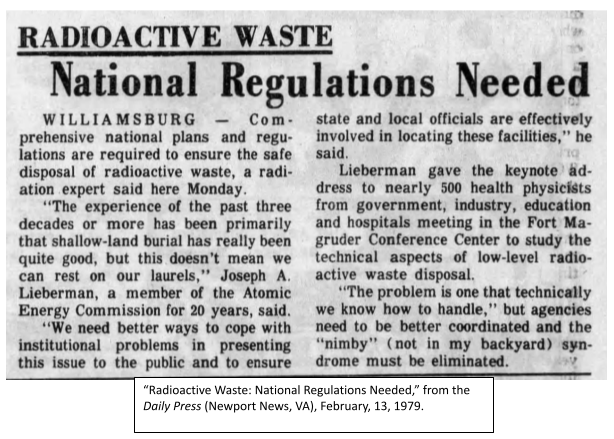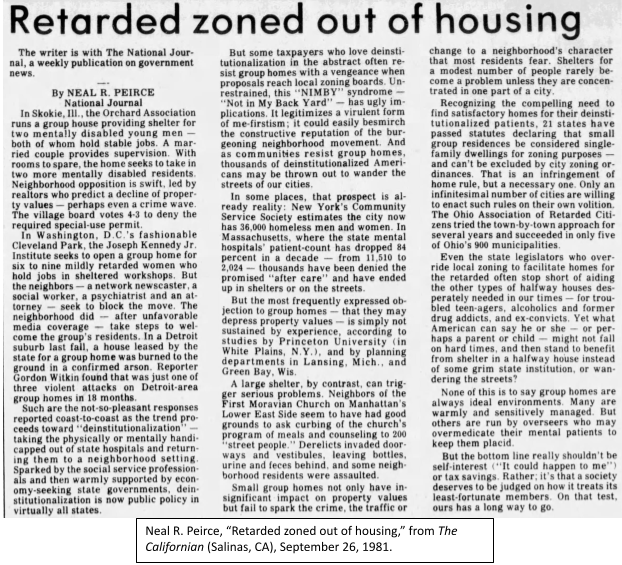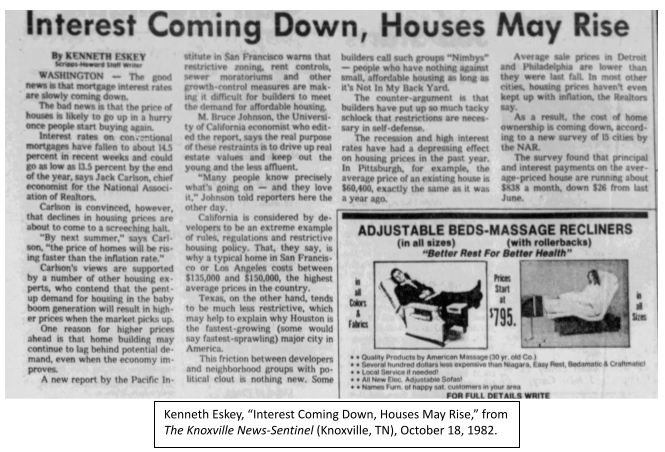NIMBY Etymology and Its Connection to the Independent Institute
I have always been interested in etymology, which can often provide interesting historical insights about whatever topic a word encompasses. Changes in language patterns in terms of the meaning and frequency of certain words can reveal much about a society’s cultural perception of a given issue.
Recently, I have been curious about the origins of the acronym NIMBY (“not in my backyard”). In popular parlance, “nimbies” are local residents who work to preserve the status quo of their neighborhoods by preventing commercial and residential construction. The acronym is most commonly reserved today for the “neighborhood defenders” who impede the construction of low-cost housing (often multifamily apartment buildings), which means that tracking the emergence and increasing frequency of the term in digital archives can serve as a useful proxy for gauging the magnitude of the housing crisis.
In searching the extensive digitized collections at newspapers.com, the earliest occurrences of the phrase “NIMBY syndrome” (the common language before the concept was shortened to “nimbyism”) came in 1979, but it did not refer originally to people opposed to new housing construction. Rather, the term was coined to describe neighborhood coalitions objecting to the disposal of nuclear waste in their towns.

In 1981, after a group of residents in Skokie, Illinois, blocked the construction of a group home for the mentally disabled, the “NIMBY syndrome” expanded to encompass neighborhood coalitions opposed to assisted-living facilities for recently deinstitutionalized mental illness patients. Here we see the first recognition of nimbies using zoning regulations to block housing developments, albeit only of a specific type.

The language of nimbyism would skyrocket in 1987 after it had broadened to apply to neighborhood groups blocking all manner of construction, particularly low-cost housing developments.[1] But the earliest instance I found of the acronym being used with this modern connotation was in 1982, in an article summarizing a report edited by economist M. Bruce Johnson and published by the Pacific Institute.

The report referenced in the article is titled “Resolving the Housing Crisis: Government Policy, Decontrol, and the Public Interest.” It focused on California’s growth-control policies, such as restrictive zoning regulations, rent controls, environmental review, and discretionary permitting. The first essay in the report was authored by economist Bernard Frieden, who, as best as I can determine, first described the concept of NIMBYism (though he did not coin the term) in his 1979 essay “The New Regulation Comes to Suburbia.” Johnson’s report provided prescient warnings about how California’s regulatory environment would inevitably lead to housing shortages and skyrocketing prices if policymakers did not reverse course.
San Francisco and Los Angeles had the highest home prices in the country, with a typical home costing upwards of $150,000 at the time (around $491,000 in today’s dollars). Today, the same home in these cities can fetch $1 million or more.[2] The problem has become acute enough that even California’s progressive population is finally starting to recognize how the skyrocketing cost of housing is driven by the policies Johnson and his contributors sounded the alarm about forty years ago, especially restrictive zoning policies.
Although the Independent Institute did not yet exist in 1982, Johnson’s report shows how far ahead of the curve the Independent Institute’s personnel has been in recognizing the public policy origins of California’s housing crisis. When the report was published, David Theroux was president of the Pacific Institute. He held the position from its founding in 1979 until 1986, when he left to establish the Independent Institute and M. Bruce Johnson followed David to serve as the Independent Institute’s founding research director.
Under their leadership, Independent offered one of the earliest and loneliest voices against the harmful policies and bloated bureaucracies that are now under wider scrutiny for their role in perpetuating the housing crisis. To give but one example, David Theroux offered this warning to California’s politicians in 1994 in his commentary on environmental policy (a favorite NIMBY tool for obstruction):
Special interest groups, who want to dictate the uses to which other people’s property will be put, compete for political favors rather than for satisfied customers. And with the shift of political power from landowners and producers to those environmentalists and their allies who are championing the expansion of political/bureaucratic means, it is more timely than ever to recognize that the political/bureaucratic arena needs to be abandoned for a system of clearly defined and enforced private property rights.
In recent years, more Americans have begun to acknowledge what David Theroux, M. Bruce Johnson, and other Independent Institute scholars have warned over so many decades. Progressives are now leading the charge against restrictive zoning in many states. Even California’s political leaders have come to acknowledge the abuses wrought by environmental review laws, among other destructive policies that have contributed to the shortage of affordable homes.
Given that the Independent Institute has been smiting at this anvil since its beginning, policymakers would be wise to finally heed our advice on resolving the housing crisis.
Notes
[1] Searches for “nimby” in newspapers.com pull 275 matches in 1980, 591 matches in 1986, 1,149 matches in 1987, and 2,222 matches in 1989. It is worth noting that the term pulls an unusually large number of mismatches, which suggests that the rough doubling in usage between 1986 and 1987 actually represents a much larger change in proper hits, assuming mismatches hold relatively constant. The term peaked in frequency in 2001 with 3,809 matches and virtually disappeared after the 2008 housing crisis. The term has enjoyed a resurgence in recent years, jumping from 294 hits in 2020 to 2,200 hits in 2021. These search results were pulled on September 1, 2023, but they will increase as newspapers.com adds more newspapers to its database, as I did not adjust for the number of issues scanned.
[2] According to Rocket Home’s Housing Market Reports for July 2023, the median home price in Los Angeles was $964,000, while the median price in San Francisco was $1.15 million.





